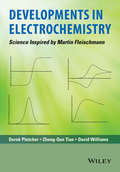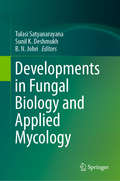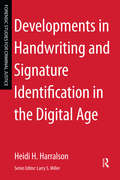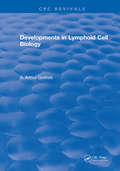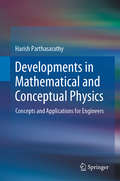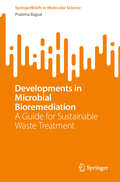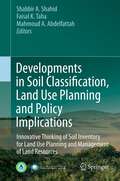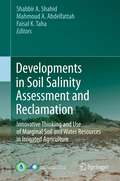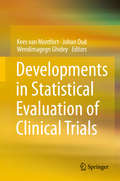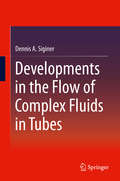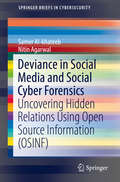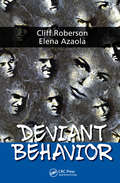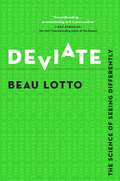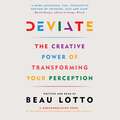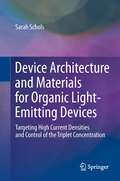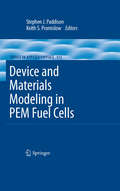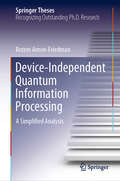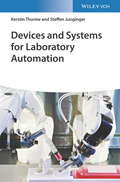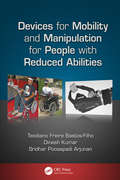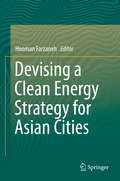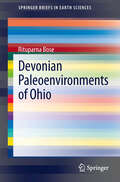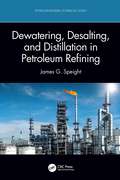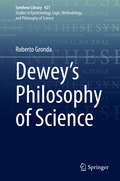- Table View
- List View
Developments in Electrochemistry
by David Williams Zhong-Qun Tian Derek PletcherMartin Fleischmann was truly one of the 'fathers' of modern electrochemistry having made major contributions to diverse topics within electrochemical science and technology. These include the theory and practice of voltammetry and in situ spectroscopic techniques, instrumentation, electrochemical phase formation, corrosion, electrochemical engineering, electrosynthesis and cold fusion. While intended to honour the memory of Martin Fleischmann, Developments in Electrochemistry is neither a biography nor a history of his contributions. Rather, the book is a series of critical reviews of topics in electrochemical science associated with Martin Fleischmann but remaining important today. The authors are all scientists with outstanding international reputations who have made their own contribution to their topic; most have also worked with Martin Fleischmann and benefitted from his guidance.Each of the 19 chapters within this volume begin with an outline of Martin Fleischmann's contribution to the topic, followed by examples of research, established applications and prospects for future developments.The book is of interest to both students and experienced workers in universities and industry who are active in developing electrochemical science.
Developments in Fungal Biology and Applied Mycology
by Tulasi Satyanarayana Sunil K. Deshmukh B. N. JohriThis book explores the developments in important aspects of fungi related to the environment, industrial mycology, microbiology, biotechnology, and agriculture. It discusses at length both basic and applied aspects of fungi and provides up-to-date laboratory-based data. Of the estimated three million species of fungi on Earth, according to Hawksworth and coworkers, more than 100,000 have been described to date. Many fungi produce toxins, organic acids, antibiotics and other secondary metabolites, and are sources of useful biocatalysts such as cellulases, xylanases, proteases and pectinases, to mention a few. They can also cause diseases in animals as well as plants and many are able to break down complex organic molecules such as lignin and pollutants like xenobiotics, petroleum and polycyclic aromatic compounds. Current research on mushrooms focuses on their hypoglycemic, anti-cancer, anti-pathogenic and immunity-enhancing activities. This ready-reference resource on various aspects of fungi is intended for graduate and post-graduate students as well as researchers in life sciences, microbiology, botany, environmental sciences and biotechnology.
Developments in Handwriting and Signature Identification in the Digital Age
by Heidi H. HarralsonThe examination of handwriting and signatures has a long and established history as a forensic discipline. With the advancement of technology in the use of digital tablets for signature capture, changes in handwriting examination are necessary. Other changes in handwriting, such as in increase in printed writing styles and the decrease in handwriting training in schools necessitates a re-examination of forensic handwriting identification problems. This text takes a fresh and modern look at handwriting examination as it pertains to forensic, legal, and criminal justice applications.
Developments in Lymphoid Cell Biology
by A. Arthur GottliebIn this volume the author by no means attempted to give a comprehensive view of the myriad of recent developments in immunology. The author has attempted, after introducing sufficient background in chapter 1, to highlight certain areas of lymphoid cell biology which are given less attention in current thinking but which seem to the author to offer exciting prospects for research. In other cases, the important topics of transplantation and tolerance are looked at from points of view which are somewhat less conventional in the hope that these aspects may stimulate others to look at the yet unsolved problems in these areas. In making the selection of topics and indeed in the selection of references within each chapter, the contributors and the author have attempted to select those which offered what seemed to be the best sources of information. They do not wish to minimize the important contributions of others but are guided by constraints of brevity and cogent expression.
Developments in Mathematical and Conceptual Physics: Concepts and Applications for Engineers
by Harish ParthasarathyThis book presents concepts of theoretical physics with engineering applications. The topics are of an intense mathematical nature involving tools like probability and random processes, ordinary and partial differential equations, linear algebra and infinite-dimensional operator theory, perturbation theory, stochastic differential equations, and Riemannian geometry. These mathematical tools have been applied to study problems in mechanics, fluid dynamics, quantum mechanics and quantum field theory, nonlinear dynamical systems, general relativity, cosmology, and electrodynamics. A particularly interesting topic of research interest developed in this book is the design of quantum unitary gates of large size using the Feynman diagrammatic approach to quantum field theory. Through this book, the reader will be able to observe how basic physics can revolutionize technology and also how diverse branches of mathematical physics like large deviation theory, quantum field theory, general relativity, and electrodynamics have many common issues that provide the starting point for unifying the whole of physics, namely in the formulation of Grand Unified Theories (GUTS).
Developments in Microbial Bioremediation: A Guide for Sustainable Waste Treatment (SpringerBriefs in Molecular Science)
by Pratima BajpaiThis book sheds new light on the transformative role of microorganisms in waste management, offering a comprehensive overview of microbial waste management strategies and their applications. Through this book, readers will learn about the latest advancements in bioremediation and microbial consortia technology, providing a fresh perspective on sustainable waste treatment solutions. The chapters cover topics such as the types and origins of waste, the importance of microorganisms in various waste management processes, and the benefits of bioremediation compared to traditional methods. Readers will discover diverse strategies for managing microbial waste, including bioleaching, bioaugmentation, and utilizing microorganisms to aid phytoremediation. The book also discusses the combined use of bacteria and microalgae for wastewater treatment and emerging innovations in microbial consortia technology. Critical attention is given to the role of microbes in multiple industrial applications such as pharmaceuticals, food processing, textiles, explosives, distilleries, and petrochemicals. Additionally, it explores bioinformatics approaches like genomics and proteomics that drive bioremediation efforts. This volume is an essential resource for researchers in environmental science, biotechnology professionals focusing on sustainable practices, scholars studying advanced wastewater treatment methods using nanotechnology or plant species integration with microorganisms. It invites readers to think through critical questions about sustainable waste treatment practices while offering valuable insights into future perspectives on microbial waste management.
Developments in Soil Classification, Land Use Planning and Policy Implications
by Shabbir A. Shahid Mahmoud A. Abdelfattah Faisal K. TahaAs the world's population continues to expand, maintaining and indeed increasing agricultural productivity is more important than ever, though it is also more difficult than ever in the face of changing weather patterns that in some cases are leading to aridity and desertification. The absence of scientific soil inventories, especially in arid areas, leads to mistaken decisions about soil use that, in the end, reduce a region's capacity to feed its population, or to guarantee a clean water supply. Greater efficiency in soil use is possible when these resources are properly classified using international standards. Focusing on arid regions, this volume details soil classification from many countries. It is only once this information is properly assimilated by policymakers it becomes a foundation for informed decisions in land use planning for rational and sustainable uses.
Developments in Soil Salinity Assessment and Reclamation
by Shabbir A. Shahid Mahmoud A. Abdelfattah Faisal K. TahaThe papers assembled here cover topics such as technological advances in soil salinity mapping and monitoring, management and reclamation of salt-affected soils, use of marginal quality water for crop production, salt-tolerance mechanisms in plants, biosaline agriculture and agroforestry, microbiological interventions for marginal soils, opportunities and challenges in using marginal waters, and soil and water management in irrigated agriculture.
Developments in Statistical Evaluation of Clinical Trials
by Kees Van Montfort Johan Oud Wendimagegn GhideyThis book describes various ways of approaching and interpreting the data produced by clinical trial studies, with a special emphasis on the essential role that biostatistics plays in clinical trials. Over the past few decades the role of statistics in the evaluation and interpretation of clinical data has become of paramount importance. As a result the standards of clinical study design, conduct and interpretation have undergone substantial improvement. The book includes 18 carefully reviewed chapters on recent developments in clinical trials and their statistical evaluation, with each chapter providing one or more examples involving typical data sets, enabling readers to apply the proposed procedures. The chapters employ a uniform style to enhance comparability between the approaches.
Developments in the Flow of Complex Fluids in Tubes
by Dennis A. SiginerThis book is dedicated to the tube flow of viscoelastic fluids and Newtonian single and multi-phase particle-laden fluids. This succinct volume collects the most recent analytical developments and experimental findings, in particular in predicting the secondary field, highlighting the historical developments which led to the progress made. This book brings a fresh and unique perspective and covers and interprets efforts to model laminar flow of viscoelastic fluids in tubes and laminar and turbulent flow of single and multi-phase particle-laden flow of linear fluids in the light of the latest findings.
Deviance in Social Media and Social Cyber Forensics: Uncovering Hidden Relations Using Open Source Information (OSINF) (SpringerBriefs in Cybersecurity)
by Nitin Agarwal Samer Al-khateebThis book describes the methodologies and tools used to conduct social cyber forensic analysis. By applying these methodologies and tools on various events observed in the case studies contained within, their effectiveness is highlighted. They blend computational social network analysis and cyber forensic concepts and tools in order to identify and study information competitors. Through cyber forensic analysis, metadata associated with propaganda-riddled websites are extracted. This metadata assists in extracting social network information such as friends and followers along with communication network information such as networks depicting flows of information among the actors such as tweets, replies, retweets, mentions, and hyperlinks. Through computational social network analysis, the authors identify influential actors and powerful groups coordinating the disinformation campaign. A blended social cyber forensic approach allows them to study cross-media affiliations of the information competitors. For instance, narratives are framed on blogs and YouTube videos, and then Twitter and Reddit, for instance, will be used to disseminate the message. Social cyber forensic methodologies enable researchers to study the role of modern information and communication technologies (ICTs) in the evolution of information campaign and coordination. In addition to the concepts and methodologies pertaining to social cyber forensics, this book also offers a collection of resources for readers including several datasets that were collected during case studies, up-to-date reference and literature surveys in the domain, and a suite of tools that students, researchers, and practitioners alike can utilize. Most importantly, the book demands a dialogue between information science researchers, public affairs officers, and policy makers to prepare our society to deal with the lawless “wild west” of modern social information systems triggering debates and studies on cyber diplomacy.
Deviant Behavior
by Cliff Roberson Elena Azaola GarridoDeviant behavior is not a subject that you study in school and then file away. It is a study of life and is ever changing. Defining the concept of deviant behavior is one of the most difficult tasks to overcome when studying the subject. Sociologists probably disagree more over the meaning of deviant behavior than any other subject. Deviant Behavio
Deviate: The Science of Seeing Differently
by Beau LottoBeau Lotto, the world-renowned neuroscientist, entrepreneur, and two-time TED speaker, takes us on a tour of how we perceive the world, and how disrupting it leads us to create and innovate. Perception is the foundation of human experience, but few of us understand why we see what we do, much less how. By revealing the startling truths about the brain and its perceptions, Beau Lotto shows that the next big innovation is not a new technology: it is a new way of seeing. In his first major book, Lotto draws on over two decades of pioneering research to explain that our brain didn't evolve to see the world accurately. It can't! Visually stunning, with entertaining illustrations and optical illusions throughout, and with clear and comprehensive explanations of the science behind how our perceptions operate, Deviate will revolutionize the way you see yourself, others and the world. With this new understanding of how the brain functions, Deviate is not just an illuminating account of the neuroscience of thought, behavior, and creativity: it is a call to action, enlisting readers in their own journey of self-discovery.
Deviate: The Science of Seeing Differently
by Beau LottoPerception is the foundation of human experience, but few of us understand how our own perception works. By revealing the startling truths about the brain and perception, Beau Lotto shows that the next big innovation is not a new technology: it is a new way of seeing.In his first major book, Beau Lotto draws on over a decade of pioneering research to show how our brains play tricks on us. With an innovative combination of case studies and optical and perception illusion exercises, DEVIATE will revolutionise the way you see the world. With this new understanding of how the brain works and its perceptive trickery, we can apply these insights to every aspect of life and work. DEVIATE is not just an engaging look into the neuroscience of thought, behaviour and creativity: it is a call to action, enlisting readers in their own journey of self-discovery.(p) 2017 Hachette Audio
Device Architecture and Materials for Organic Light-Emitting Devices
by Sarah ScholsDevice Architecture and Materials for Organic Light-Emitting Devices focuses on the design of new device and material concepts for organic light-emitting devices, thereby targeting high current densities and an improved control of the triplet concentration. A new light-emitting device architecture, the OLED with field-effect electron transport, is demonstrated. This device is a hybrid between a diode and a field-effect transistor. Compared to conventional OLEDs, the metallic cathode is displaced by one to several micrometers from the light-emitting zone, reducing optical absorption losses. The electrons injected by the cathode accumulate at an organic heterojunction and are transported to the light-emission zone by field-effect. High mobilities for charge carriers are achieved in this way, enabling a high current density and a reduced number of charge carriers in the device. Pulsed excitation experiments show that pulses down to 1 µs can be applied to this structure without affecting the light intensity, suggesting that pulsed excitation might be useful to reduce the accumulation of triplets in the device. The combination of all these properties makes the OLED with field-effect electron transport particularly interesting for waveguide devices and future electrically pumped lasers. In addition, triplet-emitter doped organic materials, as well as the use of triplet scavengers in conjugated polymers are investigated.
Device and Materials Modeling in PEM Fuel Cells
by Stephen J. Paddison Keith S. PromislowThe impact of proton exchange membrane (PEM) fuel cells on energy generation will parallel the impact of the integrated circuit on information technology. The underlying processes in PEM fuel cells have strong ties to energy generation at the mitochondrial level in organic life. The potential applications range from the micron scale to large scale industrial production. Successful integrated of PEM fuel cells into the mass-market will require new materials and a deepening understanding of the balance required to maintain the various operational states. Key areas of development include electrocatalysts for the fuel and air electrodes and membranes exhibiting good proton conductivity under minimal hydration and temperatures between -20 °C to 120 °C. New materials possessing improved properties will emerge as a result of a collaborative effort between experimentalists, engineers, and theorists, the latter doing both device and materials modeling. This book presents a series of contributed articles from scientists who have made a contribution in the modeling of fuel cells from either a device or materials perspective. As fuel cell technologies are an emerging area this book will be of interest to any working in this field. This book will provide a survey (with significant depth) of virtually all the computational and modeling work done in this area.
Device-Independent Quantum Information Processing: A Simplified Analysis (Springer Theses)
by Rotem Arnon-FriedmanDevice-independent quantum cryptography is a method for exchanging secret messages over potentially insecure quantum communication channels, such as optical fibers. In contrast to conventional quantum cryptography, security is guaranteed even if the devices used by the communication partners, such as photon sources and detectors, deviate from their theoretical specifications. This is of high practical relevance, for attacks to current implementations of quantum cryptography exploit exactly such deviations. Device-independent cryptography is however technologically so demanding that it looked as if experimental realizations are out of reach.In her thesis, Rotem Arnon-Friedman presents powerful information-theoretic methods to prove the security of device-independent quantum cryptography. Based on them, she is able to establish security in a parameter regime that may be experimentally achievable in the near future. Rotem Arnon-Friedman's thesis thus provides the theoretical foundations for an experimental demonstration of device-independent quantum cryptography.
Devices and Systems for Laboratory Automation
by Kerstin Thurow Steffen JungingerDevices and Systems for Laboratory Automation Structured Overview on the Available Systems and Devices for Laboratory Automation Choosing the right systems and devices for the automation in any given laboratory is an essential part for the process to succeed. As relevant information to make an informed choice is not always readily available, a structured overview is essential for modern scientists. This book provides an introduction into laboratory automation and an overview of the necessary devices and systems. Sample topics discussed by the two well-qualified authors include: Specific requirements the automation needs to fulfill such as liquid delivery, low volume delivery, solid delivery, and sample preparation An overview on robots and mobile robots Common interfaces in laboratory automation For scientists and all individuals working in laboratories, the work serves as an indispensable resource in helping to make laboratory processes more streamlined, effective, and efficient.
Devices for Mobility and Manipulation for People with Reduced Abilities (Rehabilitation Science in Practice Series)
by Dinesh Kumar Sridhar Poosapadi Arjunan Teodiano Bastos-FilhoThe development and application of assistive technology can help those with reduced abilities improve their quality of life and reduce their dependence on others. Written in layman's terms, Devices for Mobility and Manipulation for People with Reduced Abilities provides research and information on assistive technologies for non-technical people. Wh
Devising a Clean Energy Strategy for Asian Cities
by Hooman FarzanehThis book capitalizes on two hot topics: the Low Carbon Emission Development Strategies and climate change in Asian cities. There is resurgence in making policies to investigate more aspects of the energy-environment spectrum for the global energy market in the future. This book helps the policy makers and researchers to understand which actions should be taken to reduce the environmental impacts of economic activities in different regions in Asia. The clean energy strategy proposed in this book refers to the development and implementation of policies and strategies that simultaneously contribute to addressing climate change and solving local environmental problems, which also have other development impacts. It provides insights to a wide audience on successful ways to promote, design and implement the clean energy policies in Asian cities. To determine the global actions, it is necessary to make breakthroughs by promoting further research and to present scenarios that achieve Low Emission Development Strategies (LEDS) goals without dependence upon fossil fuels. The scenarios and case studies discussed in this book are helpful to plan for the SDGs, where various objectives have to be achieved at the same time. The UN 2030 development agenda needs innovative planning to achieve multiple goals with limited resources and generate synergy among sectors. This book will be one of the first books available on this subject.
Devonian Paleoenvironments of Ohio
by Rituparna BoseCarbonate depositional systems in the Paleozoic geologic time represent fewer studies in paleoecological interactions than the siliciclastic systems. To evaluate this difference, the paleontology of the Middle Devonian Dundee Formation in Ohio has been explored. This geologic formation represents an important environment in the Michigan Basin of North America. Understanding biotic relationships such as mutualism, commensalism, parasitism and predation in an ecological community is important in unraveling the mystery of the fossil record. This research has contributed a large field collection which will be useful in documenting the fossil content of this unit for future workers. Rituparna Bose used new microscopic and imaging techniques in qualitatively analyzing the biotic interactions in small invertebrate shells. More importantly, she solved complex hypotheses in newly emerging problems in the field of geology and paleontology, such as the biodiversity crisis. Her study involved exploring the Devonian geology and paleontology of a geologic formation of a new unexplored quarry in Ohio, namely the Whitehouse Quarry in Lucas County, Ohio. She identified Devonian brachiopods to the genus level based on their morphology, and diagnosed paleoecological entities on host brachiopods and further measured episkeletobiont traces on hosts to understand the effects of environment and evolution on extinct species. Such studies have implications in predicting future biodiversity, ecosystem conservation and climate change. This research will also assist future workers to compare the ecology of brachiopod hosts of the Dundee Limestone with that of other Devonian brachiopods, from both carbonate and siliciclastic settings.
Dew Water
by Daniel BeysensThe world’s ever-increasing need for fresh water has led to the use of non-conventional sources such as rain and fog water collection. Although rain water collection is relatively simple, the supply is often erratic. Passive fog water collection has been used in several parts of the world but is only relevant to certain geographical locations. Dew occurrence, however, is far more widespread, can form in most climates and geographic settings, show high frequency and prevalence throughout the year. During the past 20 years, dew collection has therefore been investigated as a serious supplemental source of fresh water. Dew Water offers a thorough review of dew, its formation characteristics and potential for dew collection, for audiences that include policy-makers, non-governmental organizations involved in development aid and sustainable development, engineers, urban planners, researchers and students.After providing a background on atmospheric water, humid air, and sky and materials emissivity, the book deals with dew formation and its estimation with a focus on the use of meteorological data. Dew measurement techniques are reviewed and discussed as well as dew collection by passive means. Computational fluid dynamics technique is described for better design of dew collectors. Dew quality (chemistry, biology) is assessed in view of potable water quality. Costs and economic aspects are also considered.
Dewatering, Desalting, and Distillation in Petroleum Refining (Petroleum Refining Technology Series)
by James G. SpeightThis book presents a detailed and practical description of various processes – dewatering, desalting, and distillation – that prepare refinery feedstocks for different conversion processes they will go through. Relevant process data are provided, and process operations are fully described. This accessible guide is written for managers, professionals, and technicians as well as graduate students transitioning into the refining industry. Key Features: • Describes feedstock evaluation and the effects of elemental, chemical, and fractional composition. • Details the equipment and components and possible impacts due to composition. • Explores the process options and parameters involved in dewatering, desalting, and distillation. • Considers next-generation processes and developments.
Dewey's Philosophy of Science (Synthese Library #421)
by Roberto GrondaThis monograph presents a unitary account of Dewey’s philosophy of science and demonstrates the relevance for contemporary debates. The book is written from a theoretical angle and explains Dewey's via on Experience, Language, Inquiry, Construction and Realism. Via taking this route the book addresses key philosophical problems - such as the nature of language, the idea of experience, the notion of logical constructivism, the criticism of representationalism and the nature of scientific practices.John Dewey (1859-1952) is one of the most representative philosophers of the United States. He is well known for his work in education, psychology and social reform and one of the primary figures associated with the philosophy of pragmatism. His Philosophy of Science underwent a period of almost total unpopularity and neglect. In recent times, however, as a consequence of the strong pragmatist renaissance we are now witnessing, Dewey’s philosophy of science has attracted new attention. This book presents for the first time a comprehensive overview of Dewey's philosophy of science and will be of interest to scholars working in nineteenth and twentieth century philosophy of science and on the relationship between Pragmatism and Logical Empiricism.
Dezentrale Energiewende
by Jürgen EiseltDieses Buch ist eine umfassende Bestandsaufnahme für eine bereits angelaufene dezentrale Energiewende. Es wird anhand vorhandener Strukturen, Techniken und wissenschaftlich fundierten Erkenntnissen die Potentiale einer wirkungsvollen Energiewende beschrieben. Ziel dieses Buches ist Darstellung neuer Techniken und efferktiver Konzepte, damit dezentrale Strukturen die zentrale Energieversorgung ablösen. Hauptantrieb für den Einsatz der dezentralen Energieformen sind Kostenreduzierung, energieautarke Systeme bis zur Null-Tarif-Heizung.
